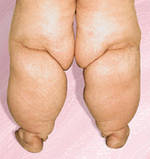In Stage I, the skin is still soft and regular, but nodular changes can be felt upon palpation (see photo #1). There are no color changes in the skin and the subcutaneous tissues have a spongy feel, like a soft rubber doll.
In Stage II, the subcutaneous tissue becomes more nodular and tough. Large fatty lobules begin to form on the medial distal and proximal thigh and medial and lateral ankles just above the malleoli (see photo # 2). Pitting edema is common, increasing as the day progresses. The individual may report hypersensitivity over the anterior tibial (shin) area. Sk in color changes occur in the lower leg, indicative of secondary lymphedema, which often occurs in later stage lipedema.
